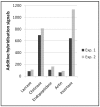A Transcriptome-Targeting EcoChip for Assessing Functional Mycodiversity
- PMID: 27605333
- PMCID: PMC5007713
- DOI: 10.3390/microarrays1010025
A Transcriptome-Targeting EcoChip for Assessing Functional Mycodiversity
Abstract
A functional biodiversity microarray (EcoChip) prototype has been developed to facilitate the analysis of fungal communities in environmental samples with broad functional and phylogenetic coverage and to enable the incorporation of nucleic acid sequence data as they become available from large-scale (next generation) sequencing projects. A dual probe set (DPS) was designed to detect a) functional enzyme transcripts at conserved protein sites and b) phylogenetic barcoding transcripts at ITS regions present in precursor rRNA. Deviating from the concept of GeoChip-type microarrays, the presented EcoChip microarray phylogenetic information was obtained using a dedicated set of barcoding microarray probes, whereas functional gene expression was analyzed by conserved domain-specific probes. By unlinking these two target groups, the shortage of broad sequence information of functional enzyme-coding genes in environmental communities became less important. The novel EcoChip microarray could be successfully applied to identify specific degradation activities in environmental samples at considerably high phylogenetic resolution. Reproducible and unbiased microarray signals could be obtained with chemically labeled total RNA preparations, thus avoiding the use of enzymatic labeling steps. ITS precursor rRNA was detected for the first time in a microarray experiment, which confirms the applicability of the EcoChip concept to selectively quantify the transcriptionally active part of fungal communities at high phylogenetic resolution. In addition, the chosen microarray platform facilitates the conducting of experiments with high sample throughput in almost any molecular biology laboratory.
Keywords: active fungal community; mRNA; precursor rRNA; quantitative microarray; soil.
Figures



Similar articles
-
Development and testing of an 18S rRNA phylogenetic microarray for marine sediments.J Microbiol Methods. 2018 Nov;154:95-106. doi: 10.1016/j.mimet.2018.10.007. Epub 2018 Oct 15. J Microbiol Methods. 2018. PMID: 30336165
-
Functional Gene Array-Based Ultrasensitive and Quantitative Detection of Microbial Populations in Complex Communities.mSystems. 2019 Jun 18;4(4):e00296-19. doi: 10.1128/mSystems.00296-19. mSystems. 2019. PMID: 31213523 Free PMC article.
-
The EcoChip: A Wireless Multi-Sensor Platform for Comprehensive Environmental Monitoring.IEEE Trans Biomed Circuits Syst. 2018 Dec;12(6):1289-1300. doi: 10.1109/TBCAS.2018.2878404. Epub 2018 Oct 31. IEEE Trans Biomed Circuits Syst. 2018. PMID: 30387742
-
Translational Metabolomics of Head Injury: Exploring Dysfunctional Cerebral Metabolism with Ex Vivo NMR Spectroscopy-Based Metabolite Quantification.In: Kobeissy FH, editor. Brain Neurotrauma: Molecular, Neuropsychological, and Rehabilitation Aspects. Boca Raton (FL): CRC Press/Taylor & Francis; 2015. Chapter 25. In: Kobeissy FH, editor. Brain Neurotrauma: Molecular, Neuropsychological, and Rehabilitation Aspects. Boca Raton (FL): CRC Press/Taylor & Francis; 2015. Chapter 25. PMID: 26269925 Free Books & Documents. Review.
-
Microarray applications in microbial ecology research.Microb Ecol. 2006 Aug;52(2):159-75. doi: 10.1007/s00248-006-9072-6. Epub 2006 Aug 8. Microb Ecol. 2006. PMID: 16897303 Review.
Cited by
-
Meta-omics data and collection objects (MOD-CO): a conceptual schema and data model for processing sample data in meta-omics research.Database (Oxford). 2019 Jan 1;2019:baz002. doi: 10.1093/database/baz002. Database (Oxford). 2019. PMID: 30715273 Free PMC article.
References
LinkOut - more resources
Full Text Sources
Other Literature Sources

